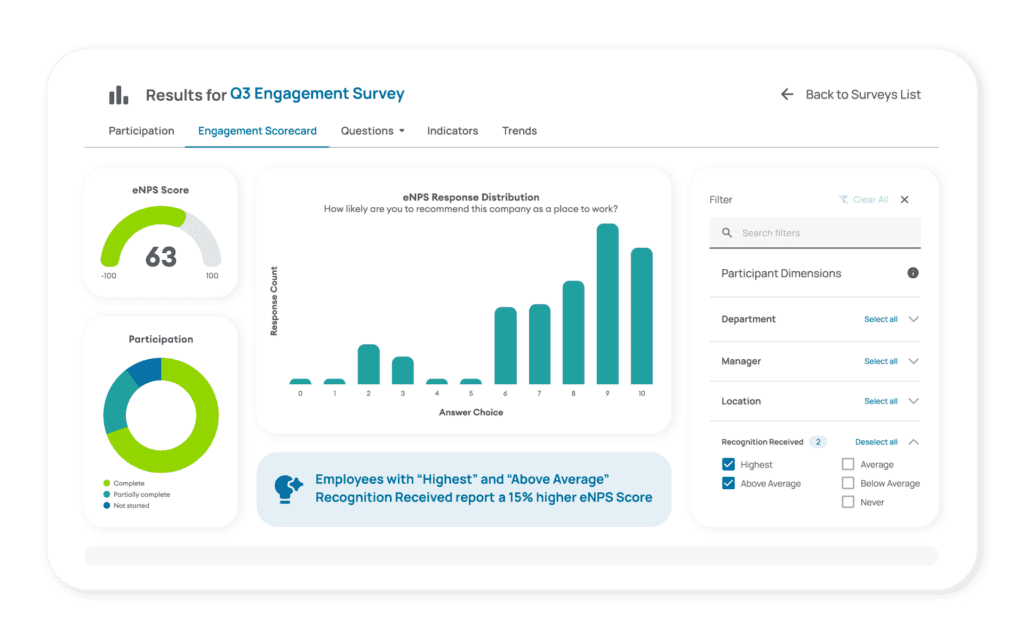November 7, 2025

Is your HR team struggling with low employee motivation and retention? Strengthening human resources engagement is one of the most effective ways to boost productivity, improve company culture, retain top talent, and increase customer satisfaction.
In this guide, we’ll explore proven HR strategies and technologies that help create a more engaged, motivated workforce.
Key Takeaways
- Human resources engagement is a critical driver of organizational success, and efforts to improve employee engagement lead to higher productivity, lower turnover, and better talent retention.
- HR leaders can boost engagement by improving communication, providing professional development, and implementing recognition programs.
- HR professionals should prioritize engagement to drive organizational success.
- Leveraging data, surveys, and technology—like engagement platforms and analytics tools—helps HR teams measure and enhance engagement effectively.
The Importance of Human Resources Engagement
Human resources engagement goes beyond employee satisfaction—it’s about creating a workplace where employees feel genuinely connected to their roles, leaders, and company mission. Engaged employees are more productive, stay longer, and contribute to a positive organizational culture.
Companies that prioritize human resources engagement enjoy stronger performance and improved retention. When employees feel valued and supported, they deliver better results and help the organization thrive. HR's responsibility is central to fostering employee engagement, managing recognition programs, and ensuring organizational buy-in from leadership and management.
Effective HR leaders use data-driven strategies to understand engagement drivers, identify gaps, and implement meaningful changes that improve morale and motivation. The role in employee engagement played by both leadership and HR is crucial, as they set expectations and create a culture that encourages participation and growth.
Understanding Employee Engagement Levels
Employees experience engagement differently. Some are deeply invested in their work, while others feel disconnected or undervalued. Highly engaged employees often outperform their less engaged peers, leading to stronger team performance.
Invested employees are more likely to inspire others and contribute to a positive workplace culture. HR leaders must identify these levels to tailor engagement initiatives effectively.
Factors such as recognition, communication, career development, and work-life balance significantly influence human resources engagement at every level of the organization, and individual employees also play a role in shaping engagement at every level.
10 Key Roles of HR Professionals in Engagement
HR teams play a pivotal role in improving human resources engagement. They design, implement, and monitor initiatives that drive employee satisfaction and organizational alignment. HR is also responsible for designing and leading employee engagement initiatives that involve company-wide participation and leadership support.
Key HR responsibilities include:
- Developing engagement strategies that foster connection and trust.
- Providing managers with tools to recognize and motivate employees.
- Building a culture that values communication, collaboration, and recognition.
When HR takes an active role in engagement, employees feel seen, supported, and inspired to contribute their best work, helping to build engaged teams across the organization.
1. Effective Onboarding Programs
Engagement starts on day one. A thoughtful onboarding process helps new hires understand company values, build relationships, and feel confident in their roles. Direct contact between new hires and managers during onboarding is essential for building trust and encouraging open communication from the start.
Structured onboarding programs set the tone for engagement and retention by aligning expectations early and making employees feel part of the organization’s mission.
2. Recognition and Reward Programs

Recognition is a cornerstone of human resources engagement. Employees who feel appreciated are more motivated, productive, and committed to their roles.
That’s where Terryberry’s employee engagement platform can make a powerful difference. Terryberry offers a comprehensive recognition solution that helps organizations celebrate milestones, achievements, and everyday wins—all in one place.
From peer-to-peer recognition to service awards and performance-based incentives, Terryberry helps HR leaders build a culture of appreciation that drives engagement and retention.
Recognition done right doesn’t just boost morale—it transforms workplace culture.
4. Intentional Employee Engagement Strategies
Improving human resources engagement requires consistent effort. HR leaders should create initiatives that support the entire employee experience—from onboarding to recognition. Improving employee engagement should be a strategic priority, as it directly impacts motivation, satisfaction, and retention.
Engagement programs that emphasize communication, recognition, and professional growth lead to measurable improvements in productivity, profitability, and retention. Highly engaged employees are more likely to contribute discretionary effort, going beyond their basic responsibilities and driving better organizational performance.
5. Utilizing Employee Engagement Surveys
Employee surveys are one of the most effective tools for gathering insights and measuring human resources engagement. An engagement survey plays a crucial role in measuring employee engagement and satisfaction, providing valuable data to inform organizational improvements.
Measuring employee engagement through well-designed surveys is essential for understanding satisfaction, motivation, and overall sentiment.
Best practices for surveys include:
- Keeping questions clear and concise.
- Encouraging honest employee feedback.
- Tracking trends over time to identify opportunities for improvement.
Collecting employee feedback through surveys is essential for continuous improvement. Turning survey results into action demonstrates that HR values employee input and is committed to ongoing progress.
6. Continuous Training and Development
Professional development fuels engagement by showing employees that their growth matters. HR should offer ongoing learning opportunities that align with both company goals and individual aspirations.
Continuous training and development directly enhance employee performance by helping staff meet clear expectations, improve skills, and achieve measurable success.
When employees feel supported in their development, they’re more likely to stay engaged, motivated, and loyal to the organization.
7. Promoting Work-Life Balance
A balanced workforce is an engaged workforce. HR can enhance human resources engagement by offering flexible work schedules, wellness programs, and mental health support.
Promoting balance helps employees recharge, prevents burnout, and improves long-term satisfaction—all of which contribute to stronger engagement and productivity.
8. Measuring Human Resources Engagement
Data-driven insights are essential for evaluating human resources engagement efforts. Key performance indicators (KPIs) such as retention rates, absenteeism, and eNPS (Employee Net Promoter Score) reveal how effectively your engagement strategies are performing.
Terryberry’s engagement dashboard simplifies this process with built-in analytics, customizable surveys, and real-time reporting. HR teams can quickly identify engagement trends and act on them to strengthen workforce motivation and morale.
9. Enhancing Communication and Feedback
Communication is the foundation of engagement. Open, transparent dialogue between employees and leadership ensures everyone feels heard and aligned with company goals.
Regular one-on-one meetings, team check-ins, and pulse surveys keep communication flowing and make employees feel connected and supported.
10. Leveraging Technology for Human Resources Engagement
Technology is transforming how HR teams engage employees. Digital tools like recognition platforms, feedback apps, and data dashboards streamline engagement initiatives and improve accessibility.
Terryberry’s all-in-one employee engagement platform integrates recognition, rewards, surveys, and analytics into a single system—making it easier for HR professionals to build meaningful connections across teams. By combining recognition with actionable insights, Terryberry helps organizations strengthen culture and boost engagement at every level.
Addressing Disengaged Employees
Disengaged employees can significantly impact team morale, productivity, and even the overall success of an organization. When employees feel disconnected, undervalued, or unsupported, their job satisfaction and well-being suffer—often leading to higher turnover and lower performance. For HR professionals, addressing disengaged employees is a crucial part of any comprehensive employee engagement strategy.
The first step in tackling disengagement is to identify its root causes. HR teams can use targeted employee engagement surveys and engagement initiatives to gather valuable insights into why some employees may feel less engaged.
These surveys help pinpoint key drivers of disengagement, such as limited career growth, lack of recognition, poor communication, or an unhealthy work-life balance. By analyzing this feedback, HR leaders can develop tailored employee engagement strategies that directly address these issues and improve employee satisfaction.
Professional development is a powerful tool for re-engaging employees. Offering opportunities for training, mentorship, and career advancement shows employees that their growth and success matter. When employees see a clear path for their own development, they are more likely to become highly engaged employees who contribute positively to the organization.
Creating a healthy work environment is equally important. HR teams should foster open communication, encourage teamwork, and support collaboration through regular one-on-one meetings and team engagement activities. Recognizing and rewarding employees for their contributions can also boost morale and help disengaged employees feel valued and motivated.
Wellness initiatives, such as flexible work arrangements and employee wellness programs, play a vital role in supporting employee well-being and work-life balance. When organizations prioritize employee wellness, they demonstrate a genuine commitment to their employees’ overall health and happiness, which can help re-engage even the most disengaged team members.
HR leaders and managers must work together to implement these engagement strategies, ensuring that every individual employee feels heard, supported, and empowered. By focusing on the unique needs of disengaged employees and providing targeted support, organizations can improve employee retention, boost morale, and drive better business results.
Summary
Fostering human resources engagement is essential for building a thriving workplace. From leadership communication and recognition programs to continuous development and technology integration, every strategy contributes to a more connected and motivated workforce.
HR leaders who embrace recognition and data-driven tools gain a competitive edge—boosting retention, morale, and productivity.
Terryberry’s employee engagement platform empowers HR professionals to bring these strategies to life by combining recognition, surveys, and analytics into one seamless experience. With Terryberry, organizations can transform engagement from a goal into a lasting cultural advantage.
Get started with Terryberry today!



